3D viewer and tools
Overview of the 3D Viewer
The 3D Viewer is accessible for:
- Composition in 3D Mode
- Scene created in Autograph
- Imported 3D Asset (.usd, .usda, etc...)
To access it, click twice on one of those item in the Project Panel. For Composition, you also need to switch it to 3D.
The Viewer will automatically switch to 3D Mode, and new Tools and Options are now available. Here we selected a Scene, with a cube. First, we will see the Transform 3D Tool (1), then the 3D Options (2).

Warning
Viewing an Imported 3D Asset directly is only for display purposes and offers little to no room for modification. The Transform 3D Tool for example is not usable in this mode. Moreover, you can't create or override cameras in the 3D Options
The Transform 3D Tool
The 3D Tools are accessible in the left side of the Viewer, just like in 2D Mode. For now, only the Transform 3D Tool is available.
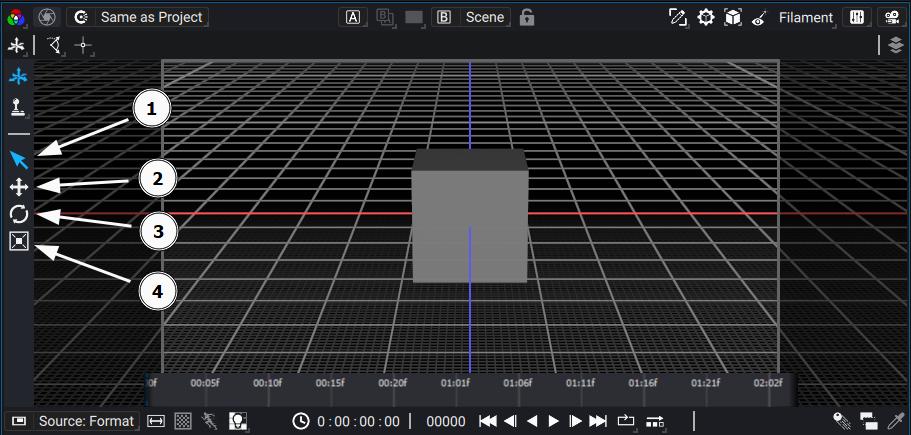
When the Transform 3D Tool is activated, 4 options are available:
- Select (Shortcut Alt+D)
- Translation (Shortcut Alt+S)
- Rotation (Shortcut Alt+R)
- Scale (Shortcut Alt+S)
You can select a 3D element in the scene with any of the 4 options, by clicking it. An object becomes highlighted when selected. To perform a multi selection, hold Shift. To deselect an element, hold Ctrl+Shift.
If any option but the default Select is activated, a corresponding gizmo will appear on selection
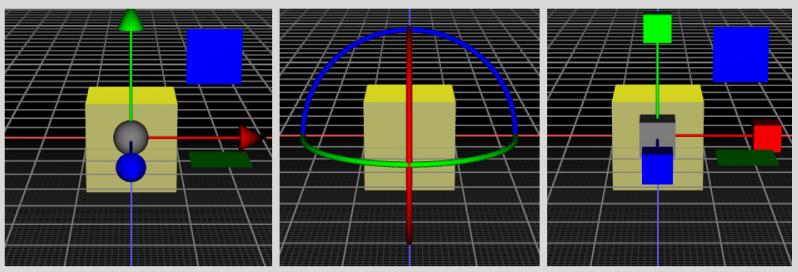
The Gizmo is here to help transform the selected object(s).
- Red means a transformation in the X axis/plane
- Green means a transformation in the Y axis/plane
- Blue means a transformation in the Z axis/plane
- Grey means a transformation in all axis
By default, the axis are shown in local mode. This means that the transformation matrix of the object will also apply to the Gizmo. You can switch to Global, (often called World) mode for locking the Gizmo axis to the world axis. You can switch mode here:
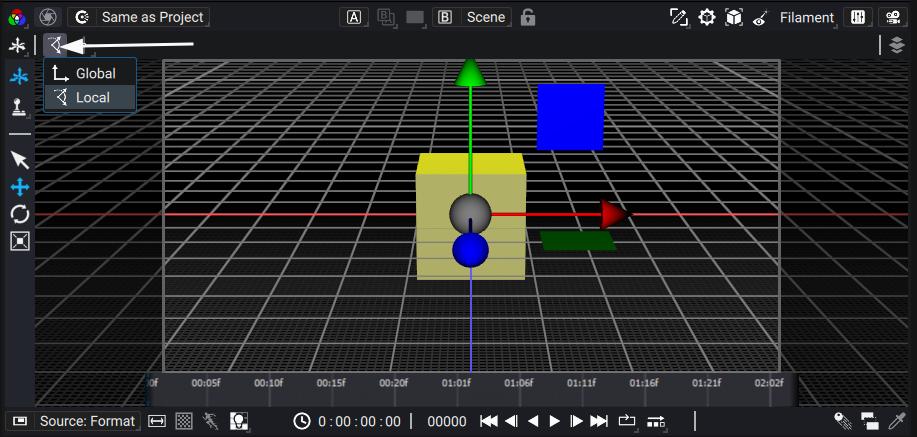
When selecting multiple objects, the default mode for barycenter is Median Point, which identically to 2D, means that the objects will be transformed relatives to the barycenter point of the selected objects.
You can also choose Individual Origins, which means that the objects will be transformed relatives to their individual barycenter, without taking into account the other objects. You can switch mode here:
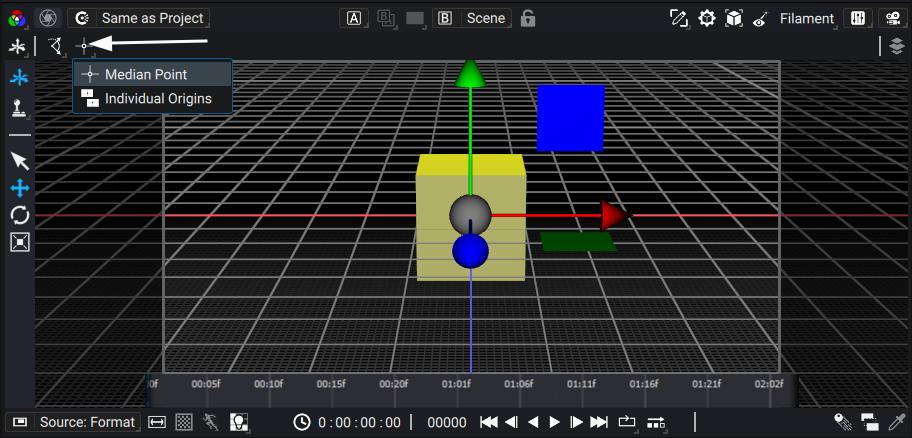
Transform 3D Tool without Gizmo
You can also manipulate objects without using the Gizmo. With an object selected:
-
Press T to enter Translate Mode.
- Default Translation is constrained to the camera plane
- While in Translate Mode, press X, Y or Z to constrain the translation along those axis.
- While in Translate Mode, press Shift+X, Shift+Y or Shift+Z to constrain on the YZ, XZ or XY plane respectively
-
Press R to enter Rotation Mode.
- Default Rotation is around the direction axis of the camera
- While in Rotation Mode, press X, Y or Z to rotate around those axis
-
Press S to enter Scale Mode
- Default Scale is a uniform scale
- While in Scale mode, press X, Y or Z to scale along those axis
- While in Scale Mode, press Shift+X, Shift+Y or Shift+Z to constrain on the YZ, XZ or XY plane respectively
Note
Pressing any constraint a second time will cycle back to Default (ie no constraint) mode.
You can validate the transform with the mouse Left Button, or cancel it with Esc or the mouse Right Button
3D Options
The 3D Options allow you to manipulate the render in the Viewer, and to perform actions such as hiding overlays or creating a new camera.

-
The Overlay Menu allows you to hide elements that can help you set up the scene but are not visible during final render. This includes the 3D Grid or all the guides for non renderable objects such as cameras or lights.
-
The Post-process Button allows you to disable the 3D Post-process to fasten the render in the viewport
-
The Frame Button allows you to frame the selected objects, or the entire scene if no objects are selected. Specifically, it means that the camera will move so that the entire bounding box of the objects (or scene) will be in the viewport. The focus/orbit point of the Camera becomes the center of the bounding box.
-
The Look At Button keeps the camera in place but make it look at the selected objects, or the entire scene if no objects are selected. Specifically, the direction vector of the camera is set on the center of the entire bounding box of the objects (or scene), while the up vector of the camera is set to the Y axis. The focus/orbit point of the Camera becomes the center of the bounding box.
-
The list of available renderers
-
The Settings menu for the chosen renderer
-
The Camera menu
The Camera Menu
The Camera Menu allows you to change the parameters of the viewport camera, create a new camera, look through an existing camera in the scene, and even directly change existing cameras parameters:
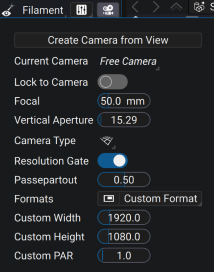
-
Create Camera From View Button creates a new camera in the scene, based on the actual viewport camera. This button is only available when the Free Camera is selected
-
Current Camera Drop-down list allows you to to look through the Free Camera (ie the viewport camera), or a camera in the scene. For a Scene created in Autograph, this means any camera available, and for Composition, this means any Camera Layer.
-
Lock to Camera Checkbox is only available when looking from an existing camera. It locks the existing camera to the viewport camera
Warning
This means that any change to the camera will be fully transferred to the locked camera and author those changes.
-
Focal and Vertical Aperture changes those parameters on the current camera
-
Camera Type Drop-down list allows to choose between Perspective and Orthographic Type
-
Resolution Gate Checkbox allows you to display or hide the Resolution Gate (ie the colored rectangle that shows the output format of the camera).
Note
The Resolution Gate is Grey if you are viewing through the Free Camera, Blue if you are viewing through an existing camera and Orange if the existing camera is locked.
-
Passepartout allows you to show or hide the overscan (ie what is outside the output format of the camera). Everything in the overscan is black if the Passepartout is set to 1
-
Formats Drop-down list allows you to change the output format of the camera. If a Custom Format is chosen, the Custom Width, Height and PAR (Pixel Aspect Ratio) are available
Moving the Camera
The Current Camera can be manipulated directly from the Viewport. The three motion are Tumble, Zoom and Pan
-
Tumble:
- Ctrl/Cmd + Left Button
- Tumble rotates the camera around the current focus/orbit point
-
Zoom:
- Mouse wheel
- Zoom moves the camera closer or further of the focus/orbit point
Note
Zoom actually moves the camera and doesn't change the focal parameter.
- Pan:
- Middle Button
- Alt + Left Button
- Pan moves the focus/orbit point according to the Camera view plane.